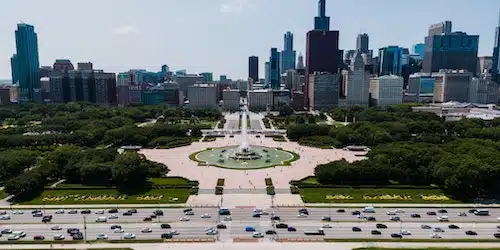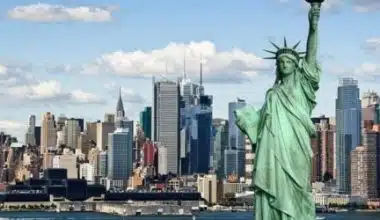Smog is sadly absent in America’s cleanest cities. Not every city can lay claim to the notoriety of being one of America’s dirtiest. Sure, clean cities don’t have the consistency of homemade gravy; they aren’t littered at every crosswalk; and they don’t smell like your neighbor’s baby’s diapers. However, you can always go to pure areas to breathe air that is practically approved. So, in accordance with experts, we’ve created a list of the cleanest cities in the US.
Cleanest Cities In The U.S.
The cleanest cities in the US have made significant efforts to prioritize cleanliness, sustainability, and environmental protection. Each city has its own unique initiatives and programs in place to maintain a clean and healthy environment for residents and visitors alike. However, numerous other cities across the United States also prioritize cleanliness and have implemented various initiatives to maintain a clean and healthy environment for their residents.
The following cities have been adjudged to be the cleanest over time:
#1. Minneapolis, Minnesota
Minneapolis consistently ranks high in terms of cleanliness. The city has implemented effective waste management systems, promotes recycling, and has a strong focus on environmental sustainability.
#2. Portland, Oregon
Portland is renowned for its commitment to sustainability and eco-friendliness. The city has a well-developed public transportation system, a high percentage of residents who commute by bike, and an extensive network of parks and green spaces.
#3. Seattle, Washington
Seattle is known for its clean streets and commitment to environmental stewardship. The city has implemented initiatives to reduce waste, increase recycling, and promote renewable energy sources.
#4. Irvine, California
Irvine is often recognized as one of the cleanest and greenest cities in the United States. The city has a comprehensive recycling program, well-maintained public spaces, and a focus on sustainable development.
#5. Madison, Wisconsin
Madison is consistently ranked as one of the cleanest cities in America. It has a strong emphasis on environmental preservation, with a high percentage of green spaces, a robust recycling program, and a commitment to renewable energy.
#6. Arlington, Virginia
Arlington consistently ranks among the cleanest cities in the U.S. The city has a well-maintained infrastructure, efficient waste management systems, and a focus on sustainable practices. Arlington also has an extensive network of parks and green spaces.
#7. San Diego, California
San Diego is often recognized for its pristine beaches, clean streets, and commitment to environmental sustainability. The city has implemented various initiatives to reduce pollution, promote renewable energy, and encourage recycling.
#8. Boise, Idaho
Boise is known for its clean air, well-maintained streets, and commitment to environmental conservation. The city has a strong focus on sustainability, with initiatives to reduce waste, promote energy efficiency, and protect natural resources.
#9. Virginia Beach, Virginia
Virginia Beach is renowned for its clean and beautiful beaches, well-kept public spaces, and commitment to environmental preservation. The city has implemented recycling programs, beach clean-up initiatives, and sustainable development practices.
#10. Austin, Texas
Austin is often recognized for its cleanliness and sustainability efforts. The city has a high percentage of green spaces, a comprehensive recycling program, and a commitment to renewable energy sources.
Factors that Make the Cleanest Cities in the US Clean
To determine the factors that make cities clean, it is important to consider various aspects of urban life and infrastructure. These factors contribute to the cleanliness of cities in the United States
#1. Effective Waste Management
Clean cities prioritize efficient waste management systems. This includes regular garbage collection, recycling programs, and proper disposal of hazardous waste. Well-implemented waste management practices help maintain cleanliness and prevent pollution.
#2. Clean Air and Water
Cities with clean air and water have lower levels of pollution, which significantly contributes to overall cleanliness. Implementing measures to reduce air pollution, such as promoting renewable energy sources, regulating emissions from vehicles and industries, and ensuring access to clean drinking water are crucial factors.
#3. Public Spaces and Infrastructure Maintenance
Clean cities maintain their public spaces, including parks, streets, sidewalks, and public facilities. Regular cleaning, proper maintenance, and prompt repairs help keep these areas clean and inviting for residents and visitors.
#4. Green Initiatives and Sustainability
Cities that prioritize sustainability and green initiatives tend to be cleaner. This includes promoting renewable energy, encouraging public transportation or bike lanes, investing in green spaces and urban forests, and implementing energy-efficient practices in buildings.
#5. Community Engagement and Education
Educating residents about the importance of cleanliness and fostering a sense of community responsibility is vital. Encouraging citizens to participate in clean-up initiatives, organizing awareness campaigns, and helping resources for proper waste disposal maintain cleanliness.
#6. Strict Environmental Regulations
Cities with stringent environmental regulations tend to have better cleanliness. These regulations ensure compliance with pollution control measures, waste management standards, and sustainable development practices.
#7. Urban Planning and Design
Cities that emphasize urban planning and design can integrate cleanliness into their infrastructure. This includes well-designed waste management systems, adequate green spaces, efficient public transportation networks, and pedestrian-friendly streets.
#8. Strict Littering Regulations and Enforcement
Clean cities often have strict regulations against littering and enforce them effectively. This discourages improper disposal of waste and promotes a clean environment. Regular monitoring, fines, and public awareness campaigns help maintain cleanliness.
#9. Green Building Practices
Clean cities encourage green building practices, which focus on energy efficiency, water conservation, and the use of sustainable materials. Green buildings help reduce the overall environmental impact, including waste generation and resource consumption.
#10. Accessible Recycling Facilities
Clean cities provide convenient access to recycling facilities and promote recycling initiatives. This includes placing recycling bins in public spaces, implementing curbside recycling programs, and educating residents on proper recycling practices.
Benefits of Living in the Cleanest Cities in the US
Living in the cleanest cities offers a lot of benefits which include
#1. Improved Health and Well-being
Clean cities have better air quality, which can lead to improved respiratory health and overall well-being for residents.
#2. Enhanced Quality of Life
Clean cities often offer a more pleasant and aesthetically pleasing environment, with well-maintained streets, parks, and public spaces, contributing to a higher quality of life for residents.
#3. Environmental Sustainability
Clean cities prioritize waste management, recycling programs, and sustainable practices, contributing to the conservation of natural resources and a reduced ecological footprint.
#4. Attractiveness for Tourism and Business
A clean, well-kept environment can leave a good impression and improve the entire experience for visitors and potential investors, making clean towns more alluring to both businesses and tourists.
#5. Community Pride and Engagement
A clean city can foster a sense of community pride and encourage residents to actively participate in keeping their surroundings clean, leading to a stronger sense of community engagement and involvement.
#6. Higher Property Values
These clean cities are generally more attractive to homebuyers and investors, leading to higher property values. A well-maintained and clean cityscape can contribute to a desirable living environment, which can positively impact property prices.
#7. Access to Green Spaces
Many clean cities often prioritize the development and maintenance of parks, gardens, and green spaces. These areas provide opportunities for recreation, relaxation, and improved mental well-being.
#8. Efficient Transportation
Clean cities often have well-maintained roads, efficient public transportation systems, and dedicated cycling or pedestrian infrastructure. This can lead to smoother commutes, reduced congestion, and improved overall transportation experiences.
#9. Environmental Consciousness
Recycling programs, renewable energy projects, and green building requirements are some examples of eco-friendly actions that are frequently prioritized in clean cities. This encourages environmental awareness and aids in sustainability initiatives.
#10. Community Spirit
Clean cities often foster a sense of community pride and engagement. Residents who take pride in their clean environment are more likely to participate in community activities, volunteer initiatives, and neighborhood improvement projects.
The Cleanest Cities In The US Adult Only
The Cleanest Cities in the US: An Adults-Only offers adults a rejuvenating break from the hustle and bustle of everyday life. The list of cleanest US cities includes Honolulu, Madison, Minneapolis, Portland, San Francisco, Seattle, and Santa Barbara. These cities have made significant efforts to maintain cleanliness and environmental sustainability, focusing on initiatives such as waste reduction, air quality improvement, and sustainable transportation. These efforts are a result of collaboration between local government, residents, and businesses.
The Cleanest Cities in the US Adults only offer a variety of things in terms of cleanliness and amenities. They include
#1. Peaceful Environment
Adult-only destinations often aim to provide a peaceful and serene atmosphere. By restricting access to adults only, these places may create a quieter and more relaxed environment.
#2. Exclusive Amenities
Adult-only resorts or communities may offer specific amenities tailored to adults, such as adult-only pools, spas, fitness centers, or entertainment options. These amenities can be designed to cater to the preferences and needs of adult guests.
#3. Privacy and Tranquility
By catering exclusively to adults, these destinations can provide an environment that focuses on privacy and tranquility. This can enhance the overall experience for adult guests seeking a peaceful and uninterrupted stay.
#4. Environmental Cleanliness
Clean cities prioritize environmental sustainability and cleanliness. They may have well-maintained public spaces, parks, and streets. Efforts to reduce pollution, promote recycling, and maintain cleanliness can contribute to a cleaner overall environment.
#5. Enhanced Services
Adult-only destinations may provide specialized services and experiences that cater specifically to adults, such as couples’ retreats, adult-oriented activities, and personalized services.
#6. Health and Safety
Clean cities often focus on maintaining high health and safety standards. They may have well-regulated food establishments, clean public facilities, and effective waste management systems. These measures contribute to a healthy and safe living or visiting environment.
#7. Cultural Attractions
Adults can enjoy a variety of cultural attractions that are available in many cities. These may include museums, art galleries, theaters, music venues, and historical sites. Clean cities often maintain and promote these attractions, ensuring they are well-maintained and accessible.
#8. Outdoor activities
Clean cities often have a focus on outdoor activities and recreation. They may offer well-maintained parks, hiking trails, biking paths, and recreational facilities for adults to enjoy outdoor pursuits.
#9. Dining and Entertainment
Adult-oriented cities may have a vibrant dining and entertainment scene. They may offer a wide range of restaurants, cafes, bars, and nightlife options that cater to adult tastes and preferences.
#10. Adult-Oriented Events and Activities
Cities that cater to adults may host adult-oriented events, such as wine festivals, food tastings, art exhibitions, or music festivals. These events provide unique experiences for adult visitors.
What Is the Cleanest City in the US?
The cleanest city in the US can vary depending on different sources and rankings. However, Honolulu, Hawaii, consistently ranks as one of the cleanest cities in the country. It is known for its efforts toward environmental sustainability and maintaining cleanliness. Other clean cities include Long Beach, California, and Milwaukee, Wisconsin.
Which are The Top 10 Cleanest Cities In The World?
The top 10 cleanest cities in the world are Singapore, Calgary, Adelaide, Honolulu, Minneapolis, Kobe, London, Zurich, Helsinki, and Ottawa. These cities consistently rank as clean, but rankings can change over time and differ from organizations’ criteria. The definition of a clean city can also be subjective and based on individual perspectives and experiences.
Which State Has the Cleanest Streets?
Honolulu, Hawaii. Honolulu tops the list as the state with the cleanest streets in the United States. However, cleanliness can vary within states and even within cities. Different factors, such as local initiatives, waste management systems, and community efforts, can contribute to the cleanliness of streets.
Is Miami a Clean City?
Miami’s cleanliness is subjective, with varying opinions. Miami has been recognized as America’s cleanest city, but perceptions can change over time. Cleanliness can also vary within different areas of the city.
Is Chicago Cleaner than New York?
The cleanliness of Chicago compared to New York is a topic of debate. A 2018 report found a “dirtiness index” of 220.9, while a comparison of pollution levels on Numbeo showed similar scores. However, discussions on City-Data Forum and PropertyClub suggest no significant difference in cleanliness. UrbanMatter lists cleanliness as a reason why Chicago is a better place to live, but this is subjective.
Which Is The No. 1 Cleanest City In The World?
Copenhagen, the capital of Denmark, is the No. 1 cleanest city in the world. The Economist and other publications have recognized it for its efforts in sustainability and cleanliness. However, it’s important to note that rankings can vary depending on different sources and criteria used to determine cleanliness.
Conclusion
Clean cities in the US prioritize effective waste management, clean air and water, public spaces, green initiatives, community engagement, strict environmental regulations, urban planning and design, strict littering regulations, green building practices, and accessible recycling facilities. These factors contribute to lower pollution levels, improved public spaces, and a healthier environment. Encouraging community engagement, strict environmental regulations, and green building practices also contribute to cleanliness. Collaboration between local government, residents, and businesses contributes to these efforts.
- SERVICE FEE AIRBNB: Detailed Guide To Airbnb Service Fees
- 17+ Most Beautiful Cities in the World 2023, Revealed (Updated)
- WHAT IS ECOTOURISM? Types, And Characteristics
- HOW TO CALCULATE AIRBNB FEES FOR HOST: All You Need To Know
- BEST PARKS IN HOUSTON IN 2023: Ultimate List






